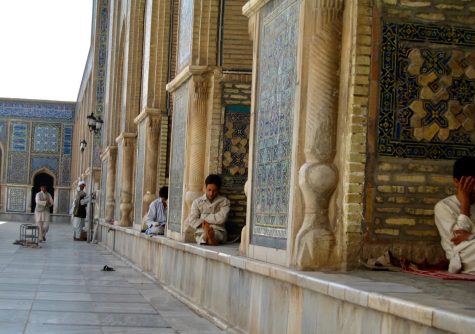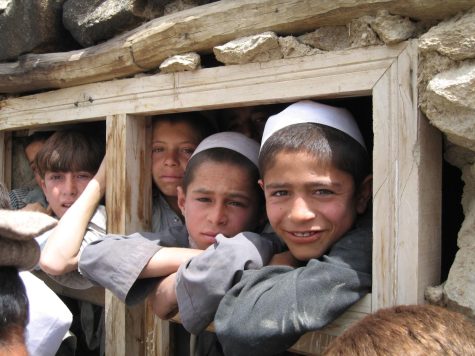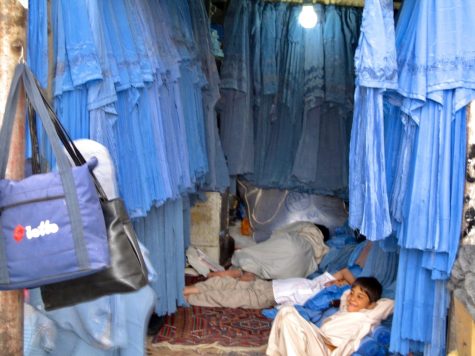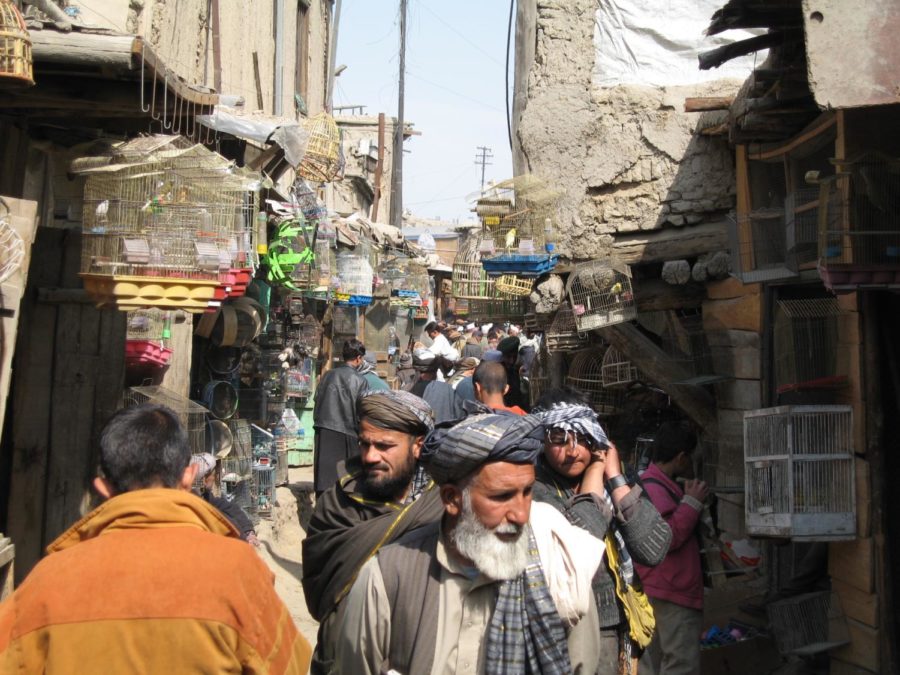Surviving the war on terror
May 20, 2022
When the American troops first arrived, Farouq Samim was optimistic about the future of Afghanistan. An overwhelming sense of hope was present at the American’s first arrival. Since 1996, the Taliban has controlled Afghanistan with an iron fist. Afghan women were oppressed by the radicalized form of Islam that the Taliban followed. Comparatively, the United States represented freedom, liberation, and renewed hope for the future of the nation.
“At the beginning, it was like heaven forever […] when the American troops and other allies came to Afghanistan, we cheered them. We were so happy […] but that didn’t stay for long,” Samim said.
In contrast, retaliation was the only thing in the minds of Americans post 9/11. As the nation was gripped by a sense of fear, the Global War on Terror was initiated by George W. Bush and the US went all in.
One of the first initiatives of the Global War on Terror was the invasion of Afghanistan.
The main aims of this were to capture Osama Bin-laden, the founder and leader of the Al Qaida terrorist organization, and to punish the Taliban for harboring Al-Qaida.
Driving out the Taliban was the easy part. With the sheer strength and budget of the American military, US forces were able to drive the Taliban out of power on December 17th, 2001 through Operation Enduring Freedom. However, disposing of the Taliban left a power vacuum, and one thing the United States was not equipped for was nation-building.

One of the glaring issues Americans saw in Afghanistan was the desperate need for organization-specific funding. Kathleen Campbell, the director of USAID operations in Afghanistan, picked up on this fact when she walked into the ministry of education for the first time in 2002.
“There were no windows in the building. There were some desks, but that was really about it. This is the Ministry of Education for the entire nation and there aren’t even papers […] And that was pretty typical for almost everywhere at the beginning,” Campbell said.
Prior to 1996, things were looking up for Afghanistan, especially in the 1960s. A more liberal attitude was present and U.S. aid money seemed to be helping improve life.
However, the Taliban’s rise to power caused major setbacks in Afghanistan’s emergence on the world stage. Infrastructure was one thing that suffered heavily, causing disparity between different organizations and facilities.
Due to this, the United States pledged billions of dollars to aid Afghanistan with programs like USAID helping to facilitate job creation and providing further economic assistance.
Michael Shaikh was part of Human Rights Watch, one of the many humanitarian organizations in the region. HRW was focused on making sure the human rights of civilians were respected during the fighting between Afghan and Western forces and the Taliban.
Shaikh witnessed the practices of NGOs in the region firsthand and how many of the larger Western aid programs were inefficient despite the large sums of money being poured into the region. At the same time, Shaikh recognized the value of local NGOs led by communities more knowledgeable about the culture of Afghanistan.
“I would say that the local NGOs are often more effective and more compassionate, then, and have a better sense of what refugees need, because they have been neighbors for millennia, […] They probably have a more nuanced and tactile feel for what’s going on, and often speak the languages and so similar languages, and share religion and common culture,” Shaikh said.

However, this isn’t to say that international NGOs don’t get anything done. Organizations such as USAID, in partnership with the Ministry of Education, have provided 171,000 students with community-based learning classes. Along with that, USAID has expanded education opportunities to over 3 million Afghan girls.
Another main facet of US intervention in Afghanistan was their military presence. As of August 2021, 800,000 American service members have served in Afghanistan. The US spent around 2.3 trillion dollars on Afghanistan, 1,488 billion of that going to military expenses. Despite this, as time went on, the Taliban began to regain power in the nation.
“When when we first lived there, I was cycling around on a bicycle in town, with my daughter on the front of the bike, and by the time I left, I was in a bulletproof car,” said Paul O’Brien, a former government advisor and the current Executive Director at Amnesty International USA.
This hindered the efficiency of international NGOs, as with more security, officials like O’Brien were less connected to the communities they were serving. Officials were not able to interact with their communities without proper protection and were not educated on the cultures present in the region.

“If you’re posted to, you know, Malawi or Mali in Africa, you know, they try and figure out that you will, if you don’t already speak the main kind of language, then they will have you go take a course in that for a few months. But there wasn’t time for training because Afghanistan was an emergency,” O’Brien said.
American soldiers were well-liked by the Afghans when they first arrived, but as time went on, perceptions began to change
“In terms of comparing the troops, they [American troops] were the most, you know, the pockets, you know, they were like, stubborn […] sometimes they, they harm more civilians, compared to other soldiers, they didn’t take precautions,” Samim said.
American soldiers who were deployed in Afghanistan were often very young and immature. 25% of soldiers deployed to Afghanistan were below the age of 25, and 84% were under the age of 35. Similar to officials like O’Brien, they were often unaware of the cultures and history of Afghanistan, their knowledge often limited to guidebooks written by those like Farouq Samim. All that they knew was they were there to protect the United States.
American lack of cultural knowledge often causes miscommunications which can cost people their lives. A prime example of this was the altercations between American troops and Afghan drivers. Due to Taliban threats, American troops had to live in a constant state of vigilance. At the same time, Afghans living in Kabul had to continue with their daily lives, whether or not there were soldiers. Miscommunications happened, and when they happened, things turned tragic fast.
“Americans are trying to tell cars to stay back and keep their distance so they can judge which cars are hostile or not. […] But some Afghans didn’t always understand what the soldiers were concerned about and ended up getting hurt in these traffic encounters with the US military,” Shaikh said.

The American presence in Afghanistan was never meant to be permanent. As early as 2008, at the time presidential candidate Barack Obama promised to remove troops from Iraq and Afghanistan. However, despite their quick loss of power after the initial months of the invasion, the Taliban had lingered in Afghanistan.
With Vietnam-Esque resentment against the war back home, former President Trump reached an agreement with the Taliban promising the removal of troops from Afghanistan.
While the true date for the date was postponed many times, President Joe Biden pledged to remove all troops from Afghanistan on August 31st, 2021. The hope was that the Afghan government would be able to consolidate control over the land they had. However as American troops began to withdraw, the Taliban quickly took back territory. It became clear that the Afghan government America had spent 20 years bolstering would not last.
Ultimately, despite the lack of preparation and against the urges of many, the last American plane departed on August 31st, 2021. The Taliban had taken full control of Afghanistan on August 15th. All of the monetary contributions by USAID, advancements in education for women, and American lives lost in trying to defeat the Taliban were effectively for nothing. The American withdrawal from Afghanistan was the most catastrophic retreat since Vietnam, and the US was leaving behind a humanitarian crisis.
With 3.5 million Afghans displaced and the Taliban quickly reinstating their radical policies, many were seeking asylum elsewhere. One of these people was Farouq Samim’s sister. However, the amnesty process for the United States and Samim’s new home, Canada was incredibly slow.
“I evacuated a sister from Afghanistan, and she was evacuated to the United States to Northern Virginia to come for a ticket, it’s called, it’s a military base. The situation in Fort Pickett was unbearable, even for an Afghan coming from a poor country,” Samim said.
Luckily, Samim was already part of a volunteer group helping refugees called Operation Abraham. Due to Samim’s connections in Afghanistan and contacts in the Canadian government, his sister was able to safely make it to Canada, however, many were not so lucky.
“We still have about 89 former colleagues and, and family members, and some female judges and people that they work with, with the Canadian troops that we’re trying to get out of Afghanistan,” Samim said.
Despite all of the chaos that has befallen Afghanistan since America’s departure, Shaikh thinks of persistence when recalling stories of the war on terror.
“We talk about surviving, but surviving is not the right word because it almost feels passive. People are persisting. Persisting to live and persisting to make opportunities for their children and themselves,” Shaikh said.
This story was originally published on Scot Scoop News on May 13, 2022.




































